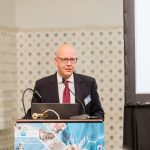Foreigners drive luxury market in Portugal
More new construction, real estate expansion in less central areas, smaller houses and a multiplicity of nationalities are some of the trends in luxury real estate that will consolidate in 2018
The Portuguese luxury real estate market is booming and so will it continue for the foreseeable future. In the most sought-after areas, such as the case of the Santo António parish, which includes the luxurious Avenida da Liberdade in the heart of the capital, an average of two luxury houses are sold every day.
And not even the exponential increase in the capital’s property prices can break this pace. In 2018, the city climbed 44 places in the ranking on cost of living, analysed in the regular study by Mercer (in which the value of housing holds the biggest weight), moving from 137 in 2017 to its current 93rd place. This increase is the biggest ever registered in this city.
Regardless, Lisbon maintains its own pace of booming revival. Avenida da Liberdade, the capital’s main avenue, is where this reality is most evident. Here, less than a decade ago, the picture was very different. Office blocks were interspersed with derelict or semi-derelict buildings, and there was little movement in the streets after 8pm. Today, not only in this parish but all around it, the real estate market is more dynamic than ever, with no signs of letting up.
Along with growing demand from a dominant group of foreigners, with French, Brazilian and Chinese leading the way, are many other nationalities that have recently discovered the country. Citizens from the USA, Kazakhstan, Turkey and South Africa are arriving in search of a safe port to capitalise on their investments and are considered “the newcomers that are standing out” by market experts. Another growing trend: the Portuguese, until very recently reluctant to buy, have started to purchase again with the help of the banks, also in the medium to high segment. Overall, this movement on the demand side is leading to a real estate expansion on the supply side that is no longer restricted to the so-called ‘prime area’ in the centre of the capital.
To meet the diversity and the number of clients, developers are expanding to other areas of the capital. The neighbourhoods of Belém, Ajuda and Alcântara have erupted, and in the last four years have attracted projects in the region of €933 million. As for the area of Estrela and Campo de Ourique, it absorbed closed to €1 billion. However, figures from the latest report from Confidencial Imobiliário (Ci), a company that specialises in property-focused information, show that the parish of Santo António is still the one that most stands out and the one that has achieved the biggest volume of investment in Lisbon in recent years. “Between 2014 and 2017, nearly €2.1 billion have been traded, with an annual average of €519.8 million. In total, 3,390 transactions have taken place in this parish in the last four years,” highlights Ricardo Guimarães, director of Ci.
Right next door, an equally bright scenario is being played out for those working in the market. The historical centre – which covers the parishes of São Vicente, Santa Maria Maior and Misericórdia (part of which is Chiado and Príncipe Real, among other neighbourhoods) – captured around €893 million in 2017 alone, split across 1,876 transactions. This equates to an average selling rate of one house a day.
“In this area it’s worth highlighting the parish of Misericórdia which, with a 44.3% increase in the invested value compared to 2016, has generated a volume of transactions of around €432 million,” notes the study.
“There is no doubt that Portugal is in vogue, and once it enters that international route, it is unlikely to stagnate. An increasing number of foreigners and many Portuguese buy to live, buy to rent out or buy simply to capitalise,” notes Beatriz Rubio, CEO of the real estate network Remax Portugal, which, through the Remax Collection, leads the sales of luxury real estate nationwide.
Having lived in Portugal for 23 years, the Spanish businesswoman recalls a similar phenomenon: “What is currently happening with Lisbon and Porto is exactly what happened with Barcelona some time ago, a city I know well. Barcelona was a pretty, cosmopolitan city that wasn’t on the real estate investment map. It was only in 1992, with the Olympics and all the publicity surrounding it, that the city was discovered. And today it is what it is.”
But the pressure of demand has its downside. Prices have been on the up, especially in the prime areas. The Price Index of the Historical Centre of Lisbon, produced by Ci in collaboration with Lisbon City Hall, shows a 67% increase since 2008, the year the index started. However, it doesn’t seem to discourage buyers, especially as the price per square metre in Lisbon continues to be more contained than in other European capitals. And that is reflected at the time of paying out – foreigners purchase assets that are 40% more expensive than what the national clients are willing to pay, with an average expenditure of €381,000.
This demand is giving the city back the dignity of times gone by, recovering buildings that had long been run down right in the middle of the capital’s high-end area. Such is the case of the Odeon cinema, an iconic building located by the busy Portas de Santo Antão, which is finally to be renovated after having its doors closed for almost three decades. Building work will start soon, with the project comprising 10 luxury apartments (from 1-bedroom to 3-bedroom duplexes) on the top floors, and a restaurant-theatre on the ground floor that will preserve the original elements, such as some of the balconies and the Art Deco-style pediment of the stage.
“The Odeon is a very special, iconic building and was abandoned for 27 years. We want to make something truly unique, and the biggest challenge is to keep as much of the building as possible and what it means to the people. So we decided to keep the stage, the mezzanines, the 24-metre-high wooden ceilings, preserve and value the heart and soul of the Odeon and which will be represented in the future restaurant covering 500sqm,” explains Julian Dufour, one of the partners of Odeon Properties.
At Remax, Beatriz Rubio also applauds the positivity unfolding in revitalising the capital. “In the old days, Lisbon was a pretty city from afar. I remember people saying that to me and I asked ‘why?’. ‘Because when you get closer, you realise the building is falling apart,’ they would answer. But that’s in the past. Lisbon is a pretty city when seen up close, as well.”
United Colors of real estate
In 2017, the acquisition of housing assets by private investors in the Urban Rehabilitation Areas of Lisbon surpassed €1.56 billion (an amount that represented around 37% of the total real-estate transactions that year), corresponding to 5,800 dwellings.
Foreigners represented around 20% of the operations, with emphasis on the French (with 21.8% of the total acquisitions by international buyers), followed by the Chinese (with 20.1%) and investors from Brazil and the UK sharing third place, each with a quota of 6.6% of the total transactions.
“And there’s more and more nationalities appearing: from Kazakhstan to Japan, from the Belgian to the German, more Turks as well as Americans. It’s all very diluted,” notes Patrícia Barão, head of the residential department at JLL. “At JLL we work with around 50 nationalities, which shows that Portugal really is trendy. While tourism keeps growing in double digits, there is no stopping this dynamic.”
The Lisbon council registered a record year in 2017 when it comes to the registration of new building licensing, with 412 new projects in the residential segment entering the pipeline (with the number of dwellings reaching a total of 3,333 units). And the market offering is meeting the expectations of the buyers: “From the dwellings in the pipeline in the historical centre in 2017, around 42.4% correspond to one-bedroom apartments, which is in keeping with what is being sought after by investors,” underlines the Ci study.
Miguel Poisson, CEO of Sotheby’s in Portugal, believes that the emergence of new projects is a trend that is set to stay in the coming years. “There are many new developments that are going to start taking shape in the next two years and bring the offering that was missing to Lisbon. The good news is that both the supply and the demand will increase in this market. And above all, because new nationalities are discovering our country.”
But the country isn’t confined to just Lisbon. From Porto (see box) to the Algarve, through to the islands, there is a dynamic being felt in every region. Miguel Poisson gives the example of Funchal, in Madeira, where Sotheby’s is in clear expansion: “There are many Portuguese who had emigrated to Venezuela and are coming back, and the same is happening to those who worked their entire lives in South Africa. The matter of safety in those countries is weighing heavily on these people’s decision to return.”
At the Portuguese Sotheby’s, 70% of clients are foreign, with the Brazilian, French and English occupying the top three biggest investors. “There are several important factors sustaining luxury real estate: the trust index in the country is very high – they are the highest this century and the arrival en masse of foreigners in Portugal will continue to stimulate the market. Besides that, investors draw the biggest profitability of their applications in the real estate sector,” stresses Miguel Poisson, recalling that “one of the things that most motivates the foreigners that have been here for longer is the fact that good assets, even at the height of the recession, devalue very little”.
Brexit’s bark worse than its bite?
In another vein, in the Algarve, everything is also moving, contrary to the predictions of those who forebode that Brexit would set off a stampede of the Brits, the region’s main foreign market.
Examples of that are the two real estate projects of Vilamoura World, which began at the same time this year to be ready in 2020. Uptown, with direct access to the centre of Vilamoura, has 134 apartments and townhouses priced at between €294,000 and half a million euros. Central, designed by the international architecture practice Petraccone & Vodar, is a closed condominium just a stone’s throw from the marina and the golf course, with 80 villas and prices reaching €1.1 million.
In one or the other, the main clients are French and British, who, even with Brexit looming, remain loyal to the Algarvean region, as Miguel Palmeiro, sales director of Vilamoura World, explains. “The traditional British market is still investing in Vilamoura. And even those who first hesitate due to the Brexit process, there is always the chance of converting the investment by way of the Golden Visa,” he adds.
On average, in 2017, the transactions made by the British were in the region of €3,400/sqm, contrasting with the average €2,800/sqm registered by the French or Northern European buyers. “So, despite the loss of purchasing power caused by the exchange rate effect, the UK continues to be a vital stage for the high end of the market, and it is worth noting the purchases above €7,500/sqm in resorts in the stretch between Albufeira and Loulé,” says the latest study on Tourism Real Estate, also conducted by Ci. It is worth remembering that the Algarvean residential market has seen increasing value, accumulating more than two years of recovering sales prices.
The demand for residential tourism properties from international investors comes essentially from three places: the UK, Northern Europe (Benelux/Scandinavia) and France. According to the study, in this sector, “over the last two years (2016 and 2017), these three markets comprised around two-thirds of the purchases made by non-residents, leading a universe of more than 40 nationalities, literally from the five continents, who invested in this type of assets”.
A second peloton, covering around 25% of the market, consists of buyers from Germany, Ireland, China, the Middle East and the USA. This block gained a quota between the years 2016 and 2017, especially because of increased demand by Middle Eastern investors, along with other nationalities that were less represented in 2016, such as the Brazilians and the Italians.
There were various nationalities with average acquisitions above €5,000/sqm. India, China, the US and Russia stand out as countries with investors looking at the high end of the residential tourism market, despite none individually exceeding a quota of 4% of buyers. According to market players, these are dynamics that will consolidate over the course of this year.
And the most expensive places in the capital are…
The luxury market has hit new heights with each passing quarter. According to the calculations of Confidencial Imobiliário, right now the central areas of Lisbon are reaching an average close to €8,000 per square metre (€7,970, to be exact). There are three neighbourhoods above this threshold, which include Chiado, Barata Salgueiro (near Avenida da Liberdade) and Avenida da República, says the report. Here, the market reaches peak prices of over €10,000 per square metre. If we widen it to a top 5 of priciest neighbourhoods, we can include Bairro da Bica and Sé, both with price tags above €8,500/sqm. Extending the ranking of higher price ranges, we can find Santa Marta in sixth place, followed by Bairro da Andaluz (near Avenida Duque de Loulé) and the São Paulo / Boavista / Conde stretch.
Source: Confidencial Imobiliário
Porto is also thriving
The numbers are more modest, but Porto, the country’s second city, seems to be a better option than ever for investing, often with higher profitability than that seen in Lisbon, where prices are already very high.
In 2017, 389 properties were traded in the historical centre of Porto, in an investment volume that surpassed around €119 million. This figure represents a 48% increase on the €80 million invested in 2016, concluded Confidencial Imobiliário in a study published in early June. Compared to 2015, the 2017 investment growth is even more marked, with transaction amounts increasing by 180%.
Recently, the estate agent Predibisa, which specialises in real estate in the north of the country, conducted a survey of clients and investors to ascertain the main factors that lead people to choose the city nicknamed Invicta. “The welcoming atmosphere was the most common answer. The majority noted the affection of most Porto natives, as well as the ease of integration in the city. The quality of life, security, the city’s beauty, the culture, the food and the climate are also reasons that explain the growing attraction for this city,” noted Predibisa in a press release.










